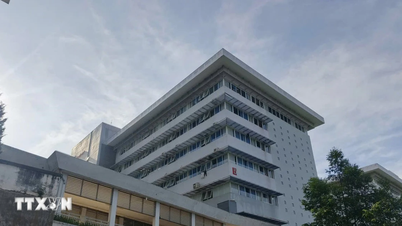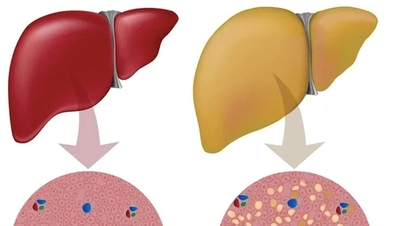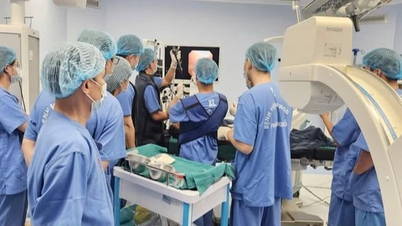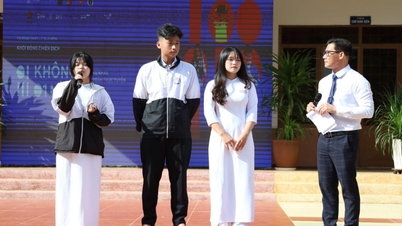
Mooncake Energy Levels You Need to Know
According to nutritional data from the National Institute of Nutrition, a traditional baked mooncake weighing about 180 to 200 grams contains an average of 700 to 900 kilocalories. This energy level is equivalent to 2 to 3 bowls of white rice or a full main meal.
Even the seemingly lighter mooncakes still have calories ranging from 600 to 800 kilocalories each. Mooncakes with salted egg yolks, mixed ingredients, or added Chinese sausage, fat, and sugar often contain more cholesterol and saturated fat, increasing the risk of dyslipidemia.
Doctor Chu Thi Dung, University of Medicine and Pharmacy Hospital , Ho Chi Minh City, branch 3, shared that how to enjoy moon cakes is a big concern for people living with diabetes.
For healthy people, eating a portion of mooncake is enough to keep them full for several hours. But for people with diabetes, the refined sugar and rapidly absorbed starch in the cake can cause a sudden increase in blood glucose, forcing the body to work hard to regulate it.
When blood sugar levels are high, patients can easily feel tired, thirsty, dizzy or nauseous. If this condition occurs frequently and for a long time, it will affect cardiovascular function, kidney and vision.
Reasonable moon cake servings for people with diabetes
According to Dr. Dung, people with diabetes do not necessarily have to abstain from moon cakes completely. The important thing is to understand how to choose, control portion sizes and the right time to eat.
According to the World Health Organization's guidelines, diabetics should maintain a balanced diet, reduce foods containing simple sugars, and increase fiber and protein to slow down the absorption of sugar. Therefore, if you want to enjoy mooncakes, you should consider them as part of your daily starch intake, not as a side dish.
In terms of portion, patients should only eat about 1/8 to 1/4 of a 180 gram cake at each meal. This amount is equivalent to 100 to 200 kilocalories, suitable for the body to control the energy intake level.
Eating cake 1-2 hours after a main meal is a reasonable time, because at this time the stomach already has protein and fiber to help slow down sugar absorption, limiting sudden increases in blood sugar. You should not eat cake late at night, because the process of sugar and fat metabolism slows down when resting, causing blood sugar to easily increase overnight.
When choosing cakes, diabetics should prioritize less sweet cakes, cakes specifically for diabetics or homemade cakes with reduced sugar content. Some manufacturers now use natural sweeteners such as stevia, maltitol or isomalt instead of regular sucrose.
Fillings such as green beans, lotus seeds, red beans or oats are better than mixed fillings, salted eggs or Chinese sausage. However, even though they are “diet” cakes, their energy is still high because they contain flour, oil and seeds, so patients should not eat a lot or continuously for many days.
In addition, you should avoid eating cakes with soft drinks, condensed milk or bottled fruit juice because these drinks increase the amount of sugar absorbed into the blood.
Drinking a cup of green tea or water after eating not only helps reduce the sweetness but also aids in better fat digestion. For people taking hypoglycemic drugs or insulin, monitoring blood sugar levels one to two hours after eating is essential to adjust the medication dose promptly.
To balance energy during the day, if you have eaten mooncakes, you should reduce the amount of starch or other fruits in your diet. For example, if you eat about a quarter of a mooncake (equivalent to two small bowls of rice), you can reduce the portion of rice in your main meal or skip the sweet dessert.
After eating cake, maintaining light exercise such as walking for 20 to 30 minutes is also a way to help the body use energy effectively, supporting more stable blood sugar control.
"People with diabetes should consider enjoying moon cakes as a small joy with spiritual meaning rather than a need to eat. A small piece of cake eaten slowly, sipping tea and sharing with loved ones can still bring the feeling of a full reunion festival without affecting health.
In cases where blood sugar is not controlled stably, there are cardiovascular complications or are undergoing active treatment, patients should consult a doctor or nutritionist before using the cake," Dr. Dung recommended.
In addition to commercial cakes, many families now choose to make their own healthier moon cakes by using whole wheat flour, reducing sugar, adding oats, chia seeds, lotus seeds or red beans.
This type of cake has a lower glycemic index, is rich in fiber and minerals, suitable for people who need to control blood sugar. However, no matter how healthy the ingredients are, the total calories still need to be calculated to avoid excess energy.
According to the recommendations of the National Institute of Nutrition of Vietnam in 2024, diabetics should maintain a balanced diet between complex starch, lean protein, green vegetables and healthy fats.
Eating moon cakes, if any, should be counted as part of the daily energy intake and not exceed the overall needs. Along with that, regular physical activity of at least 30 minutes a day will help improve insulin sensitivity and reduce long-term complications of the disease.
For normal people, eating too many moon cakes can also lead to weight gain and metabolic disorders, so limiting portions is not only for diabetics. The habit of dividing the cake into small pieces, eating with family, enjoying with tea instead of eating the whole cake alone is a way for everyone to fully enjoy the traditional flavor while still maintaining health.
Source: https://nhandan.vn/luong-calo-trong-banh-trung-thu-va-luu-y-cho-nguoi-dai-thao-duong-post913182.html




![[Photo] Prime Minister Pham Minh Chinh launched a peak emulation campaign to achieve achievements in celebration of the 14th National Party Congress](https://vphoto.vietnam.vn/thumb/1200x675/vietnam/resource/IMAGE/2025/10/5/8869ec5cdbc740f58fbf2ae73f065076)
![[Photo] Opening of the 13th Conference of the 13th Party Central Committee](https://vphoto.vietnam.vn/thumb/1200x675/vietnam/resource/IMAGE/2025/10/6/d4b269e6c4b64696af775925cb608560)

![[Photo] Prime Minister Pham Minh Chinh chairs the Government's online conference with localities](https://vphoto.vietnam.vn/thumb/1200x675/vietnam/resource/IMAGE/2025/10/5/264793cfb4404c63a701d235ff43e1bd)


















![[Photo] Opening of the 13th Conference of the 13th Party Central Committee](https://vphoto.vietnam.vn/thumb/402x226/vietnam/resource/IMAGE/2025/10/6/d4b269e6c4b64696af775925cb608560)


































































Comment (0)